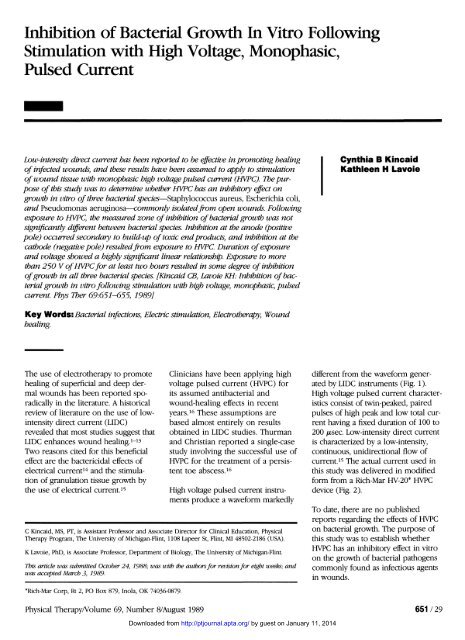Inhibition of Bacterial Growth In Vitro Following ... - Physical Therapy
Inhibition of Bacterial Growth In Vitro Following ... - Physical Therapy
Inhibition of Bacterial Growth In Vitro Following ... - Physical Therapy
You also want an ePaper? Increase the reach of your titles
YUMPU automatically turns print PDFs into web optimized ePapers that Google loves.
<strong><strong>In</strong>hibition</strong> <strong>of</strong> <strong>Bacterial</strong> <strong>Growth</strong> <strong>In</strong> <strong>Vitro</strong> <strong>Following</strong><br />
Stimulation with High Voltage, Monophasic,<br />
Pulsed Current<br />
Low-intensity direct current has been reported to be effective in promoting healing<br />
<strong>of</strong> infected wounds, and these results have been assumed to apply to stimulation<br />
<strong>of</strong> wound tissue with monophasic high voltage pulsed current (HVPC). The purpose<br />
<strong>of</strong> this study was to determine whether HVPC has an inhibitory effect on<br />
growth in vitro <strong>of</strong> three bacterial species—Staphylococcus aureus, Escherichia coli,<br />
and Pseudomonas aeruginosa—commonly isolated from open wounds. <strong>Following</strong><br />
exposure to HVPC, the measured zone <strong>of</strong> inhibition <strong>of</strong> bacterial growth was not<br />
significantly different between bacterial species. <strong><strong>In</strong>hibition</strong> at the anode (positive<br />
pole) occurred secondary to build-up <strong>of</strong> toxic end products, and inhibition at the<br />
cathode (negative pole) resulted from exposure to HVPC. Duration <strong>of</strong> exposure<br />
and voltage showed a highly significant linear relationship. Exposure to more<br />
than 250 V <strong>of</strong> HVPC for at least two hours resulted in some degree <strong>of</strong> inhibition<br />
<strong>of</strong> growth in all three bacterial species. [Kincaid CB, Lavoie KH: <strong><strong>In</strong>hibition</strong> <strong>of</strong> bacterial<br />
growth in vitro following stimulation with high voltage, monophasic, pulsed<br />
current. Phys Ther 69:651-655, 1989]<br />
Cynthia B Kincaid<br />
Kathleen H Lavoie<br />
Key Words: <strong>Bacterial</strong> infections, Electric stimulation, Electrotherapy, Wound<br />
healing.<br />
The use <strong>of</strong> electrotherapy to promote<br />
healing <strong>of</strong> superficial and deep dermal<br />
wounds has been reported sporadically<br />
in the literature. A historical<br />
review <strong>of</strong> literature on the use <strong>of</strong> lowintensity<br />
direct current (LIDC)<br />
revealed that most studies suggest that<br />
LIDC enhances wound healing. 1 - 13<br />
Two reasons cited for this beneficial<br />
effect are the bactericidal effects <strong>of</strong><br />
electrical current 14 and the stimulation<br />
<strong>of</strong> granulation tissue growth by<br />
the use <strong>of</strong> electrical current. 15<br />
Clinicians have been applying high<br />
voltage pulsed current (HVPC) for<br />
its assumed antibacterial and<br />
wound-healing effects in recent<br />
years. 16 These assumptions are<br />
based almost entirely on results<br />
obtained in LIDC studies. Thurman<br />
and Christian reported a single-case<br />
study involving the successful use <strong>of</strong><br />
HVPC for the treatment <strong>of</strong> a persistent<br />
toe abscess. 16<br />
High voltage pulsed current instruments<br />
produce a waveform markedly<br />
C Kincaid, MS, PT, is Assistant Pr<strong>of</strong>essor and Associate Director for Clinical Education, <strong>Physical</strong><br />
<strong>Therapy</strong> Program, The University <strong>of</strong> Michigan-Flint, 1108 Lapeer St, Flint, MI 48502-2186 (USA).<br />
K Lavoie, PhD, is Associate Pr<strong>of</strong>essor, Department <strong>of</strong> Biology, The University <strong>of</strong> Michigan-Flint.<br />
This article was submitted October 24, 1988; was with the authors for revision for eight weeks; and<br />
was accepted March 3, 1989.<br />
different from the waveform generated<br />
by LIDC instruments (Fig. 1).<br />
High voltage pulsed current characteristics<br />
consist <strong>of</strong> twin-peaked, paired<br />
pulses <strong>of</strong> high peak and low total current<br />
having a fixed duration <strong>of</strong> 100 to<br />
200 µsec. Low-intensity direct current<br />
is characterized by a low-intensity,<br />
continuous, unidirectional flow <strong>of</strong><br />
current. 15 The actual current used in<br />
this study was delivered in modified<br />
form from a Rich-Mar HV-20* HVPC<br />
device (Fig. 2).<br />
To date, there are no published<br />
reports regarding the effects <strong>of</strong> HVPC<br />
on bacterial growth. The purpose <strong>of</strong><br />
this study was to establish whether<br />
HVPC has an inhibitory effect in vitro<br />
on the growth <strong>of</strong> bacterial pathogens<br />
commonly found as infectious agents<br />
in wounds.<br />
*Rich-Mar Corp, Rt 2, PO Box 879, <strong>In</strong>ola, OK 74036-0879.<br />
<strong>Physical</strong> <strong>Therapy</strong>/Volume 69, Number 8/August 1989 651/29<br />
Downloaded from http://ptjournal.apta.org/ by guest on January 11, 2014
















